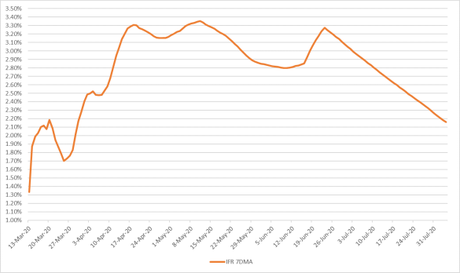This blog post is based on data which was recent as of 4th August, 2020.
Fatality rates are important for acute infectious diseases, especially novel ones like COVID-19 as it is a metric which reflects the severity of the disease, helps to triage high risk groups and gear up the health systems to respond to the disease threat. There are two metrics which provide the relevant information for this measure: case fatality ratio (CFR) and infection fatality ratio (IFR). To clarify, IFR is based on the number of deaths noted amongst all infected individuals, whereas CFR is the proportion of deaths noted in confirmed, identified cases. Given the epidemiological and clinical characteristics of COVID-19, there are a lot of uncertainties around the IFR, particularly since it may be difficult to identify all mild, asymptomatic or presymptomatic infected individuals.
One important distinction to be noted is that the CFR calculated during an ongoing outbreak or epidemic is biased by the fact that there are many active or ongoing cases, which are yet to resolve. As some of these cases would, inevitably, result in deaths, unless the denominator is adjusted to reflect all resolved cases, the CFR is likely to be an underestimate. Hence, an adjusted CFR would be measured as:

If this definition of CFR, based only on resolved cases is taken into account, India currently has a CFR of 3.06%.
As of the time of writing this note, India has recorded 1,855,745 cases and 38,938 deaths, giving the crude CFR of 2.1%. On charting the 7-day moving average of CFR, we find that there was an inflection point on 23 rd June, 2020, when the crude CFR was noted to be 3.27%. Beyond this point, there has been a steady, almost linear trend of reduction in the CFR. The following figure elucidates this.

If this trend were to hold, it may be expected that within a very short period of time, the CFR should come down to around 2%. However, the CFR depends on several things, which would also determine whether this trajectory continues to hold or not. These include:
- Appropriate reporting of deaths. Right now this is perhaps the biggest challenge - are we able to capture all the deaths that are occurring due to COVID-19 in India? If not, then, obviously, the numerator will be under-estimated and both the mortality rates discussed above will be under estimated.
- Number of tests conducted. As more and more tests are done, cases are detected more efficiently. More cases of mild or presymptomatic cases are detected. As an overwhelming majority of these cases are likely to have favorable outcomes, not resulting in deaths, the CFR will continue to decrease.
- Test positivity rate. This metric indicates if the testing strategy is adequately covering the persons at risk, and the momentum of the spread of infection in a locality. WHO has a broad recommendation that a TPR of less than 10% indicates that there is an adequate coverage of testing in a given location. If the TPR is high, it is likely to indicate that the testing is picking up only a proportion of cases, likely those who are symptomatic and seeking healthcare services. This is likely to translate into a higher CFR, as the testing strategy would be underestimating the denominator - the total number of cases.
- Improved management strategies. As clinical strategies for management of COVID-19 become more evidence based and more experiential learning accumulates, case management is bound to improve and result in fewer adverse outcomes.
- Improved health systems responses. Given that early case detection and management is the key to controlling adverse outcomes in any disease condition, as health system responses to COVID-19 continue to strengthen, more patients who are at a higher risk of adverse outcomes (e.g. elderly individuals or persons with comorbidities) will be shielded more effectively or managed more assiduously, leading to reduction in deaths.
Given that the IFR is dependent on so many factors, especially the testing coverage and test positivity rate, it is incorrect to expect a linear trend of reduction in the CFR. However, the trend of the last 6 weeks shows an almost linear reduction, and if this trend were to continue, a CFR of around 2%, could potentially be reached soon. However, as indicated in the post, this remains conditional on several mitigating factors.
